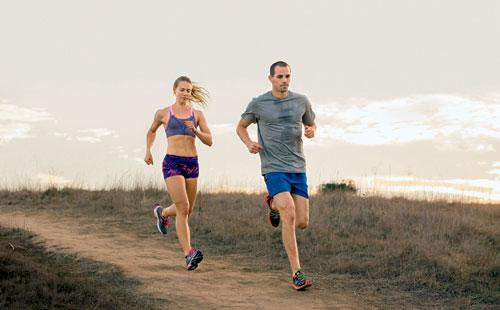
Train on descents – without getting hurt – to build strength, boost coordination, and even have some fun.
When most runners tackle hills, they focus on the difficulty of the climb. But downhill running poses its own set of challenges – and rewards.
Descending feels easy aerobically, but each step triggers muscle-damaging eccentric contractions in the quadriceps and lower legs, says Greg Wells, Ph.D., an exercise physiologist at the University of Toronto and the author of Superbodies: Peak Performance Secrets from the World’s Best Athletes. On level ground, these muscles shorten as they fire; on declines, they elongate while under tension as they work to control your speed. This creates more micro-tears in each fiber, which stimulates muscle growth but leaves you fatigued and sore. That’s one reason the Boston Marathon, with its four-mile downhill opening stretch, is such a hard course.
Practicing running down hills prepares your body to handle these eccentric contractions, decreasing the negative effects and improving your performance on net-descent courses like Boston’s. But even if you’re not training for a hilly race, you can benefit from incorporating regular downhill running into your routine: The muscle you build working on the decline translates into faster paces on any terrain. You will be able to run faster with less effort, giving you the ability to perfect your technique at near-top speeds. And then there’s something any kid could tell you: “Downhill training can be a tremendous amount of fun,” Wells says. Here’s how to safely enjoy the way down.
Select Your Slope
You can practice downhill running through either focused repeats or an extended run on a hilly route (see “Perfect the Plunge,” below). Either way, you’ll want to choose your hills wisely, says Sean Coster, an exercise physiologist and running coach at Complete Running in Portland, Oregon. Extreme grades – say, 20-percent drops – increase the impact too much (and the risk of ankle, hip, and knee injuries). Instead, look for a gradual slope of no more than eight percent. (To determine the grade, use a GPS watch that tracks elevation: Run up the hill and then scope your data for the elevation change. Divide this by the distance you ran in feet to get the slope – .08 equals eight percent.) Choose softer, more forgiving surfaces, such as grass or gravel, if you’re new to downhill work. But if you’re training for a hilly road race, progress to some paved declines in the months beforehand to practice, says Rebekah Mayer, national training manager at Minneapolis-based Life Time Run.
Focus On Form
Use mental cues to optimize your form and reduce your injury risk. Instead of looking at your feet, pretend you have a grapefruit nestled between your chin and your chest, Coster says. This keeps your gaze 10 to 15 meters in front of you and your posture upright. Engage your core and lean forward slightly from the ankles, aligning your upper body over your lower body or even slightly ahead of it – battling your natural tendency to lean backward and slow down, Mayer says. As you descend, shorten your stride and quicken your cadence. That way, you’ll take lighter steps and land more on your midfoot instead of using your heel as a brake. And keep a slight bend in your landing leg to avoid absorbing all the impact in your knee, Wells says.
Time It Wisely
If you’re planning for a descent-filled race, begin adding downhill workouts early in your training schedule. “As with any new training type, it’s always best to start small,” Mayer says. Begin with one downhill session every other week. Eventually, you can work up to one or two per week, but schedule another only when you’ve completely recovered from the previous one, Wells says. If you’re running a race with extremely steep downhills, make at least a few of these workouts race-effort runs that include similar terrain, Coster says – but avoid downhill repeats on such sharp declines. And dial things back again as your race nears. Avoid pushing the pace on downhills two to three weeks beforehand, when the risk of injury outweighs the benefits, Mayer advises.
http://www.runnersworld.com/running-tips/three-tips-for-running-downhill

Recent Comments